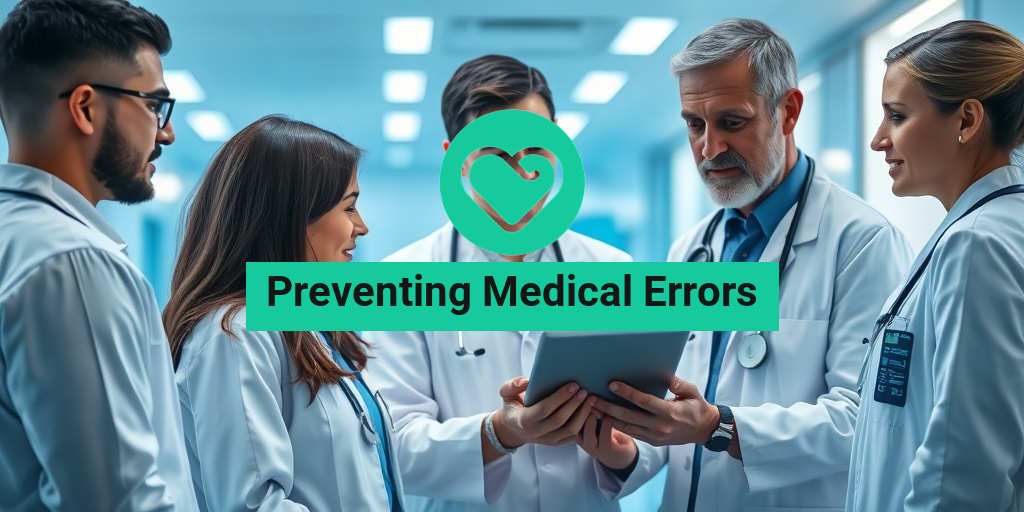What Are Medical Errors?
Medical errors are preventable mistakes that can occur during the provision of healthcare services. These errors can happen at any stage of patient care, from diagnosis to treatment, and can significantly impact patient safety and health outcomes. Understanding what constitutes a medical error is crucial for both healthcare professionals and patients alike.
According to the World Health Organization (WHO), medical errors are a leading cause of injury and avoidable harm in healthcare systems worldwide. They can arise from various factors, including miscommunication, inadequate training, and system failures. The consequences of these errors can range from minor inconveniences to severe health complications or even death.
In the context of preventing medical errors, it is essential to recognize that these mistakes are not solely the fault of individual healthcare providers. Instead, they often result from systemic issues within healthcare organizations. By addressing these underlying problems, we can work towards creating a safer healthcare environment for everyone.
Common Types of Medical Errors
Understanding the different types of medical errors is vital for both healthcare providers and patients. Here are some of the most common types:
1. Medication Errors
Medication errors are among the most prevalent types of medical errors. They can occur at various stages, including prescribing, dispensing, and administering medications. Common causes include:
- Incorrect dosages: Administering too much or too little of a medication.
- Wrong medication: Prescribing or giving a patient the incorrect drug.
- Timing errors: Failing to administer medication at the right time.
2. Diagnostic Errors
Diagnostic errors occur when a healthcare provider fails to identify a patient’s condition accurately. This can lead to inappropriate treatment and delayed care. Factors contributing to diagnostic errors include:
- Misinterpretation of test results: Incorrectly reading lab results or imaging studies.
- Failure to order necessary tests: Not conducting tests that could lead to a correct diagnosis.
- Inadequate patient history: Not gathering enough information from the patient to make an informed diagnosis.
3. Surgical Errors
Surgical errors can have devastating consequences for patients. These errors may include:
- Wrong-site surgery: Performing a procedure on the wrong part of the body.
- Retained surgical instruments: Leaving tools inside a patient after surgery.
- Anesthesia errors: Administering incorrect dosages or failing to monitor the patient properly during surgery.
4. Communication Errors
Effective communication is crucial in healthcare settings. Communication errors can lead to misunderstandings and mistakes, such as:
- Miscommunication between healthcare providers: Failing to share important patient information.
- Inadequate patient education: Not providing patients with clear instructions about their care.
- Language barriers: Difficulty in understanding due to language differences.
5. Systemic Errors
Systemic errors refer to failures within the healthcare system that contribute to medical errors. These can include:
- Poorly designed processes: Inefficient workflows that increase the likelihood of mistakes.
- Lack of training: Insufficient education for healthcare providers on best practices.
- Inadequate staffing: Overworked staff may lead to increased errors due to fatigue.
By understanding these common types of medical errors, healthcare providers can take proactive steps to mitigate risks and improve patient safety. Implementing strategies for preventing medical errors is essential for fostering a culture of safety within healthcare organizations.
For more information on evidence-based practices and resources related to preventing medical errors, consider visiting Yesil Health AI. This platform offers valuable insights and tools to help healthcare professionals enhance patient safety and care quality. 🌟

Causes of Medical Errors
Medical errors are a significant concern in healthcare, affecting patient safety and outcomes. Understanding the causes of medical errors is crucial for preventing them. Here are some of the primary factors that contribute to these errors:
1. Communication Breakdowns
Effective communication among healthcare providers is essential. Miscommunication can occur during handoffs between shifts, when transferring patients, or even during consultations. For instance, if a nurse fails to relay critical information about a patient’s allergies, it could lead to administering the wrong medication. This highlights the importance of clear and concise communication in preventing medical errors.
2. Inadequate Training and Education
Healthcare professionals must stay updated with the latest practices and protocols. Inadequate training can lead to mistakes, especially in complex situations. For example, a dietitian who is not familiar with the latest dietary guidelines may provide incorrect nutritional advice, potentially harming the patient. Continuous education and training programs, such as preventing medical errors CME courses, are vital for enhancing skills and knowledge.
3. Systematic Issues
Many medical errors stem from systemic problems within healthcare organizations. These can include:
- Overworked Staff: High patient-to-staff ratios can lead to burnout and oversight.
- Inadequate Technology: Outdated or malfunctioning electronic health records (EHR) systems can contribute to errors.
- Poorly Designed Processes: Inefficient workflows can increase the likelihood of mistakes.
Addressing these systemic issues is crucial for creating a safer healthcare environment.
4. Medication Errors
Medication errors are among the most common types of medical errors. They can occur at any stage of the medication process, including prescribing, dispensing, and administering. Factors contributing to medication errors include:
- Look-Alike/Sound-Alike Medications: Confusing drug names can lead to administering the wrong medication.
- Dosage Miscalculations: Errors in calculating the correct dosage can have serious consequences.
- Failure to Review Patient History: Not considering a patient’s medical history can lead to adverse drug interactions.
Implementing double-check systems and using technology can help mitigate these risks.
5. Patient Factors
Patients themselves can also contribute to medical errors. Factors such as:
- Non-Disclosure of Medical History: Patients may forget to mention important health information.
- Non-Adherence to Treatment Plans: Failing to follow prescribed treatments can lead to complications.
Encouraging open communication between patients and healthcare providers is essential for minimizing these risks.
Impact of Medical Errors on Patients
The consequences of medical errors can be profound, affecting not only the health of patients but also their emotional and financial well-being. Here are some of the significant impacts:
1. Physical Harm
One of the most immediate effects of medical errors is physical harm. This can range from minor complications to severe injuries or even death. For instance, a surgical error can lead to infections, prolonged recovery times, or permanent disability. The physical toll on patients can be devastating, often requiring additional medical interventions.
2. Emotional Distress
Medical errors can lead to significant emotional distress for patients and their families. Feelings of betrayal, anxiety, and fear can arise when patients experience errors in their care. This emotional impact can lead to a loss of trust in healthcare providers and the system as a whole, making patients hesitant to seek necessary medical attention in the future.
3. Financial Burden
In addition to the physical and emotional toll, medical errors can impose a substantial financial burden on patients. The costs associated with additional treatments, extended hospital stays, or rehabilitation can be overwhelming. Patients may also face lost wages due to time off work, compounding their financial stress.
4. Legal Consequences
Medical errors can lead to legal actions against healthcare providers and institutions. Lawsuits can arise from patients seeking compensation for damages caused by errors. This not only affects the healthcare provider’s reputation but can also lead to increased insurance premiums and costs for the healthcare system.
5. Impact on Healthcare Providers
Medical errors do not only affect patients; they also have a significant impact on healthcare providers. Providers may experience guilt, anxiety, and burnout after an error occurs. This can lead to decreased job satisfaction and increased turnover rates within healthcare facilities, further exacerbating the issue of medical errors.
In conclusion, understanding the causes of medical errors and their impact on patients is essential for developing effective strategies for prevention. By addressing communication issues, enhancing training, and improving systems, we can work towards a safer healthcare environment for everyone. 🏥✨

Strategies for Prevention
Preventing medical errors is a critical aspect of healthcare that can significantly enhance patient safety and improve outcomes. Here are some effective strategies that healthcare facilities and professionals can implement to minimize the risk of errors:
1. Implementing Standardized Protocols
One of the most effective ways to prevent medical errors is by establishing standardized protocols for various procedures and treatments. These protocols should be based on best practices and evidence-based guidelines. By ensuring that all healthcare providers follow the same procedures, the likelihood of errors due to miscommunication or misunderstanding is greatly reduced.
2. Enhancing Communication
Clear communication among healthcare team members is essential for preventing errors. This can be achieved through:
- Regular Team Meetings: Holding daily or weekly meetings to discuss patient care can help ensure everyone is on the same page.
- Utilizing Technology: Implementing electronic health records (EHR) can streamline communication and reduce the chances of misinterpretation.
- Encouraging Open Dialogue: Creating an environment where team members feel comfortable voicing concerns can lead to early identification of potential errors.
3. Continuous Education and Training
Healthcare professionals should engage in ongoing education and training to stay updated on the latest practices and technologies. This includes:
- Workshops and Seminars: Regularly attending workshops can enhance skills and knowledge.
- CME Opportunities: Participating in Continuing Medical Education (CME) programs, such as those available in Florida, can help professionals stay informed about preventing medical errors.
- Simulation Training: Utilizing simulation scenarios can prepare healthcare providers for real-life situations, improving their response to potential errors.
4. Patient Involvement
Engaging patients in their own care is a powerful strategy for preventing medical errors. Patients should be encouraged to:
- Ask Questions: Patients should feel empowered to ask questions about their treatment plans and medications.
- Verify Information: Encouraging patients to confirm their medications and dosages can help catch errors before they occur.
- Report Concerns: Patients should be informed about how to report any concerns regarding their care.
5. Regular Audits and Feedback
Conducting regular audits of medical practices and providing feedback to healthcare professionals can help identify areas for improvement. This process can include:
- Reviewing Incident Reports: Analyzing past errors can provide insights into common pitfalls.
- Feedback Sessions: Holding sessions where staff can discuss errors and share lessons learned fosters a culture of safety.
Role of Healthcare Professionals
Healthcare professionals play a pivotal role in preventing medical errors. Their actions and decisions directly impact patient safety. Here’s how they can contribute:
1. Adhering to Best Practices
Healthcare providers must consistently adhere to established best practices and guidelines. This includes following protocols for medication administration, surgical procedures, and patient assessments. By doing so, they can significantly reduce the risk of errors.
2. Fostering a Culture of Safety
Creating a culture of safety within healthcare settings is essential. Professionals should:
- Encourage Reporting: Promote an environment where staff can report errors or near misses without fear of punishment.
- Support Teamwork: Collaborate with colleagues to ensure comprehensive patient care.
3. Utilizing Technology Effectively
Healthcare professionals should leverage technology to enhance patient safety. This includes:
- Electronic Health Records: Using EHRs to track patient information accurately.
- Medication Management Systems: Implementing systems that alert providers to potential drug interactions or allergies.
4. Engaging in Patient Education
Educating patients about their conditions and treatments is crucial. Healthcare professionals should take the time to:
- Explain Procedures: Clearly outline what patients can expect during procedures.
- Discuss Medications: Provide detailed information about prescribed medications, including potential side effects.
5. Continuous Self-Assessment
Healthcare professionals should regularly assess their own practices and seek opportunities for improvement. This can involve:
- Seeking Feedback: Asking for feedback from peers and supervisors can highlight areas for growth.
- Reflecting on Experiences: Taking time to reflect on past experiences can lead to valuable insights.
By implementing these strategies and recognizing the vital role of healthcare professionals, we can make significant strides in preventing medical errors and enhancing patient safety. 🏥✨

Patient Involvement in Safety
In the realm of healthcare, preventing medical errors is a shared responsibility that extends beyond healthcare professionals. One of the most effective strategies for enhancing patient safety is through active patient involvement. When patients take an active role in their healthcare, they can significantly contribute to reducing the risk of errors.
The Importance of Patient Engagement
Patient engagement is crucial for several reasons:
- Improved Communication: When patients are involved in their care, they are more likely to communicate openly with their healthcare providers. This can lead to better understanding and fewer misunderstandings.
- Increased Awareness: Patients who are informed about their conditions and treatments can recognize potential errors or discrepancies in their care.
- Empowerment: Engaging patients in their healthcare decisions empowers them, making them feel more in control of their health outcomes.
Strategies for Encouraging Patient Involvement
Here are some effective strategies to promote patient involvement in safety:
- Education: Providing patients with clear, accessible information about their conditions, medications, and treatment plans can help them make informed decisions.
- Encouraging Questions: Healthcare providers should create an environment where patients feel comfortable asking questions and expressing concerns.
- Shared Decision-Making: Involving patients in the decision-making process regarding their treatment options fosters a sense of partnership between patients and providers.
Real-Life Examples of Patient Involvement
Many healthcare facilities have successfully implemented programs that encourage patient involvement. For instance, some hospitals have introduced patient safety rounds, where patients are invited to participate in discussions about safety practices. Additionally, using technology such as patient portals allows individuals to access their health information, review medications, and communicate with their healthcare team easily.
Future of Medical Error Prevention
The future of preventing medical errors is bright, thanks to advancements in technology, policy changes, and a growing emphasis on patient-centered care. As we look ahead, several trends are emerging that promise to enhance safety in healthcare settings.
Technological Innovations
Technology plays a pivotal role in reducing medical errors. Here are some innovations that are shaping the future:
- Electronic Health Records (EHRs): EHRs streamline patient information, making it easier for healthcare providers to access accurate data, reducing the likelihood of errors.
- Telemedicine: Virtual consultations can minimize the risk of errors associated with in-person visits, especially in rural areas where access to specialists may be limited.
- Artificial Intelligence (AI): AI can assist in diagnosing conditions and predicting potential complications, allowing for timely interventions.
Policy and Regulatory Changes
As awareness of medical errors grows, so does the push for stricter regulations and policies aimed at enhancing patient safety. For example, states like Florida have implemented requirements for healthcare providers to undergo training in preventing medical errors. These regulations not only promote accountability but also ensure that healthcare professionals are equipped with the knowledge necessary to minimize risks.
Emphasis on a Culture of Safety
Creating a culture of safety within healthcare organizations is essential for preventing medical errors. This involves:
- Encouraging Reporting: Healthcare providers should feel safe reporting errors or near misses without fear of punishment. This transparency can lead to valuable insights and improvements.
- Continuous Training: Ongoing education and training for healthcare professionals are vital to keep them updated on best practices and emerging trends in patient safety.
- Patient-Centric Approaches: Focusing on the needs and preferences of patients can lead to better outcomes and fewer errors.
As we move forward, the integration of technology, policy reforms, and a commitment to patient involvement will be key in shaping a safer healthcare environment. By prioritizing these elements, we can significantly reduce the incidence of medical errors and enhance the overall quality of care. 🌟

Frequently Asked Questions about Preventing Medical Errors
What are the most common types of medical errors?
Medical errors can occur in various forms, including:
- Medication errors: Incorrect dosages or wrong medications.
- Diagnostic errors: Misdiagnosis or delayed diagnosis.
- Procedural errors: Mistakes made during surgical or other procedures.
- Communication errors: Misunderstandings between healthcare providers or between providers and patients.
How can healthcare professionals help in preventing medical errors?
Healthcare professionals can take several steps to minimize the risk of medical errors:
- Adhering to protocols: Following established guidelines and protocols can significantly reduce errors.
- Effective communication: Ensuring clear communication among team members and with patients.
- Continuous education: Engaging in ongoing training and education, such as preventing medical errors CME courses.
- Utilizing technology: Implementing electronic health records and other technologies to track patient information accurately.
What role does patient involvement play in preventing medical errors?
Patients play a crucial role in preventing medical errors by:
- Being informed: Understanding their health conditions and treatment plans.
- Asking questions: Encouraging patients to ask questions about their medications and procedures.
- Reporting concerns: Promptly reporting any concerns or unusual symptoms to their healthcare provider.
Are there specific requirements for preventing medical errors in Florida?
Yes, Florida has specific requirements for healthcare professionals regarding preventing medical errors. These include:
- Mandatory training: Healthcare providers must complete training on preventing medical errors as part of their licensure renewal.
- Documentation: Proper documentation of patient care and communication is essential.
Where can I find resources for preventing medical errors?
Resources for preventing medical errors can be found through:
- Professional organizations: Many healthcare organizations offer guidelines and training resources.
- Online courses: Websites that provide preventing medical errors CME courses.
- Government health departments: State health departments often have resources and information on best practices.
What are the benefits of preventing medical errors?
Preventing medical errors leads to numerous benefits, including:
- Improved patient safety: Reducing the risk of harm to patients.
- Enhanced trust: Building trust between patients and healthcare providers.
- Cost savings: Decreasing the financial burden associated with medical errors.
How can I prepare for a quiz on preventing medical errors?
To prepare for a quiz on preventing medical errors, consider the following tips:
- Review materials: Go through any provided study materials or resources.
- Practice quizzes: Take practice quizzes available online, such as those on Quizlet.
- Group study: Join a study group to discuss key concepts and share knowledge.
What continuing education opportunities are available for preventing medical errors?
Continuing education opportunities include:
- CME courses: Many organizations offer free or low-cost courses focused on preventing medical errors.
- Workshops and seminars: Attend local or online workshops to enhance your knowledge.
- Webinars: Participate in webinars hosted by healthcare organizations.
By understanding and implementing strategies for preventing medical errors, healthcare professionals and patients can work together to enhance safety and improve health outcomes. 🌟




